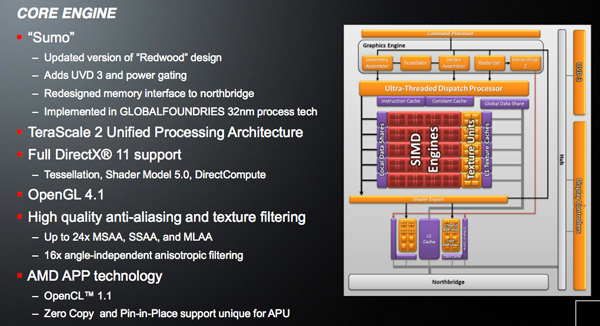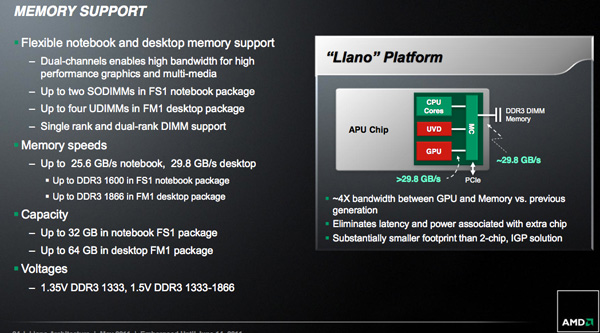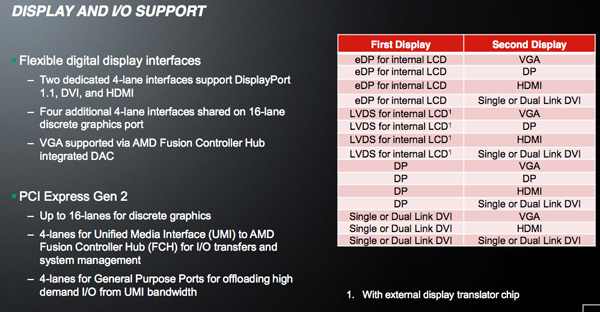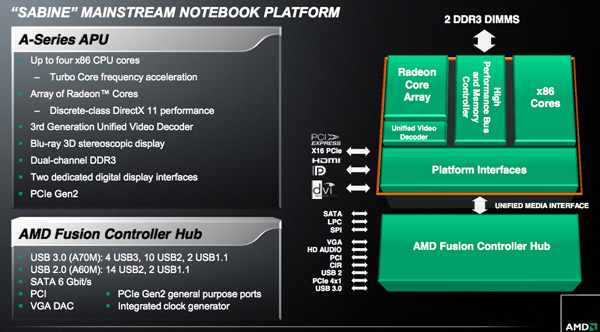The AMD Llano Notebook Review: Competing in the Mobile Market
by Jarred Walton & Anand Lal Shimpi on June 14, 2011 12:01 AM ESTThe GPU
While the Llano CPU cores may be in need of a major overhaul, Llano's GPU is as new as it gets. Technically based off of AMD's Redwood core (Radeon HD 5570) with some enhancements, Llano's GPU is codenamed Sumo.
The DX11 GPU features five SIMD arrays, each with 80 cores for a total of 400 shader processors. Similar to the updates we saw with this year's Northern Islands GPUs, Sumo does add UVD3 support to the Redwood architecture. Of course since Sumo shares the same die as the Llano CPU cores it is built on GlobalFoundries' 32nm process, making this the first AMD GPU fabbed at GlobalFoundries and not TSMC.
For everything behind the memory controller Sumo is virtually identical to Redwood. Where Sumo differs is in its memory interface. Although Llano is AMD's first performance oriented APU, it's still constrained by a 128-bit wide DDR3 memory interface. That dual-channel memory interface has to be shared by all four Llano cores as well as the Sumo GPU and as a result, arbitration is very important.
AMD shared a few choice details about the Llano memory controller architecture. To begin, AMD guarantees more than 30GB/s of bandwidth is available between the GPU and the memory controller—in other words, the path from GPU to the memory controller won't become a bottleneck. The GPU/memory controller link (i.e. within the APU die) can apparently scale up to as much as 50GB/s to support future APUs with even faster memory interfaces. Note that unlike previous integrated graphics solutions, there is no support for dedicated external memory—this is a pure shared memory architecture.
Second, and most importantly, AMD can dynamically prioritize memory bandwidth between the CPU and GPU. In most cases, when both processors are heavily consuming data, the GPU is given priority over the CPU. Given today's workloads, prioritizing the GPU for memory accesses makes sense when it's running full tilt. The chances of you stressing all four CPU cores and running at full GPU memory bandwidth requirements are pretty slim today.
With 400 shader processors behind a shared 128-bit DDR3 memory interface, the upper bound for Sumo performance is the Radeon HD 5570. In practice, you should expect performance to be noticeably lower since the GPU does have to share its precious memory bandwidth with up to four x86 CPU cores.
The mobile version of Llano supports up to DDR3-1600 while the desktop parts can run at up to DDR3-1866. Maximum memory capacities are 32GB and 64GB for notebooks and desktops, respectively.
Llano has a total of 24 PCIe Gen 2 lanes at its disposal. Sixteen of those lanes can be used for external graphics. Four of the lanes can be used for devices that need low latency/high bandwidth access to the APU itself (e.g. Gigabit ethernet). The remaining four lanes are used to connect the APU to its sole partner in crime: the Fusion Controller Hub.
AMD is particularly proud of the display output configurations supported by Llano. The possible combinations are listed below:
Chipsets
AMD will offer two Fusion Controller Hubs (FCHs) as options for Llano: A70M and A60M. The only difference between the two is in their support for USB 3.0; the A70M has four USB 3.0 ports while the A60M has none.
Both FCHs support 6Gbps SATA and perform just as well as AMD's 8-series chipset (or Intel's Z68) with a high performance SSD. USB 3.0 performance is also comparable to 3rd party solutions we've seen deployed on motherboards already.















177 Comments
View All Comments
ET - Tuesday, June 14, 2011 - link
So, what do you tell them? The only benchmarks of The Sims 3 I could find are pretty old and didn't offer much detail, but I think based on them that high quality would require more than the lowest IGP. (Then again, normal or low quality should probably run fine on anything.)msroadkill612 - Tuesday, August 2, 2011 - link
ta 4 the post - but dont salesmen have a duty to sell them a bit of insurance against the next game fadash9 - Tuesday, June 14, 2011 - link
Bring on the OpenCL apps, excuse me applications- Excel rewritten to take advantage of heterogeneous computing would silence everyone about Star CPU cores. The ball is in the hands of the people (to buy them), then the software developers (to program for them) - that's why Star cores? APU apps neededmsroadkill612 - Tuesday, August 2, 2011 - link
I think it will happen. Big mobs will identify niches that can profit from OGPL & profit from using it - open languages always win in the end.I see fusion server apuS in the future.
FISHRULE - Tuesday, June 14, 2011 - link
What a terrible CPU, who would want something that performs like a Phenom in a new computer circa 2011. The future might be fusion AMD, but you sure as heck aren't part of the future anymore.jabber - Tuesday, June 14, 2011 - link
90% of laptop owners wouldnt know if they were using a Brazos or an i5 in their laptops.The only real differential is in transcoding, ripping etc. and very few folks in the real world actually do that. Especially on laptops.
Price is far more important than outright performance. Has been for some time now.
RussianSensation - Tuesday, June 14, 2011 - link
False. My gf doesn't know anything about computers. But she somehow knew that Intel makes the best mobile CPUs even before asking me what to get. Clearly Intel marketing > AMD's. All of my current friends who just bought a computer all went with i3/i5/i7 processors only because they "heard" Sandy Bridge is the fastest CPU around.Llano is nothing more than a Phenom with a faster GPU. Phenom already didn't sell well against C2D/C2Q/Core i7 (1st) gen and isn't getting any better against SB. The only way AMD is gaining market share is if they ship cheap laptops with Llano to users for whom the price of a laptop is the most important factor.
ET - Tuesday, June 14, 2011 - link
Well, you have pretty computer literate friends. Most people I know would have no idea what Sandy Bridge is, probably not even what i3 and i5 are, and would only buy i3 or i5 because: a) AMD had very little market presence until now; b) I'd recommend them. That said, most of the people I know have no idea that AMD exists and is making CPU's (I mention it occasionally, and they're always surprised, so I guess it doesn't register), so it does look like AMD's marketing is pretty crappy.That said, I think that your analysis of why Llano will fail isn't right. For most people the CPU power really doesn't matter that much. They'd have no idea if i3 or Llano is better, and most likely won't be able to tell the difference in practice (unless they run a game for which the HD 3000 is unsuited). Sure Llano is for the low end market, but that's where most sales are, and it's certainly much improved in terms of power usage, which is an important enough measure to help it gain market share.
RussianSensation - Tuesday, June 14, 2011 - link
You are probably right that most people won't tell the difference between a Llano or an i3/i5/i7. But to them the perception of knowing that they have a slower CPU is what matters. One of my friends was building a PC for browsing the net only. I told him he'd be perfectly fine with a $100 CPU but he insisted that the system must have Sandy Bridge because it's the latest modern CPU. I gave up trying to convince him that his internet browsing experience will be more limited by his ISP latency and speed rather than CPU performance.So as long as AMD convinces the average consumer that Llano is at at least as good, they will do well. The problem is AMD's marketing department is worse than a 1st year undergrad student studying marketing in business school. They think if they pay millions of dollars to put AMD on F1 cars, people will notice?
You made a very important point - a lot of people don't even know what AMD is or that there is another competitor to Intel. Imagine if GM, Ford or Chrysler made cars that were more reliable than Honda or Toyota. It would still be a while until the average consumer would abandon the Japanese brands since the perception of reliability would lag behind reality. AMD has this similar problem with their CPU brands, which only marketing can fix.
jrs77 - Tuesday, June 14, 2011 - link
Really... that's rather unimpressive.The GPU of Llano beats intels HD-graphics in games, what a surprise. But how many people do I know personally, that play games on their laptops anyways? Laptops are primarily used as mobile office-computers and they do still rely more on CPU-performance.
From all the experience I've made the HD3000 graphics of mobile SNB CPUs are perfectly fine for all tasks I throw at them (excluding games). So the question is, why would I buy a Llano-based laptop instead of a SandyBridge one?
Llano doesn't offer better battery-life so the only reason might be the price, but with i5-2xxx laptops starting at $600 I really don't see alot of competition there for intel, if we're talking anything else then gaming.